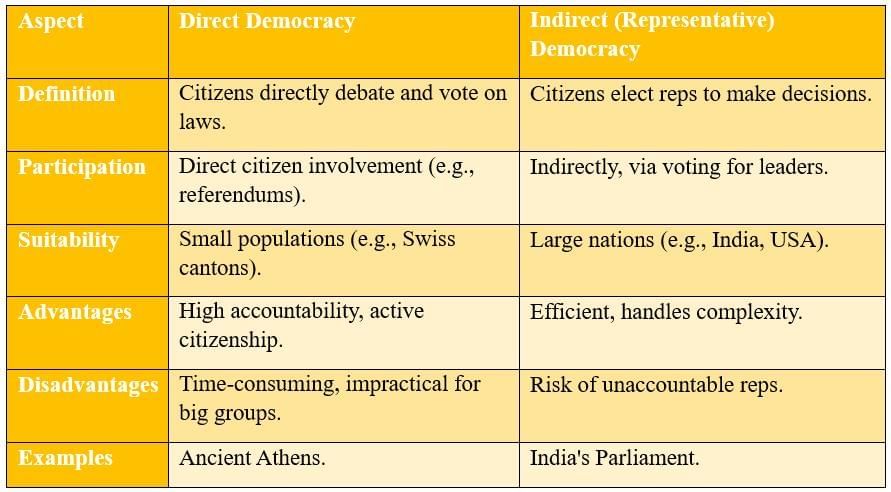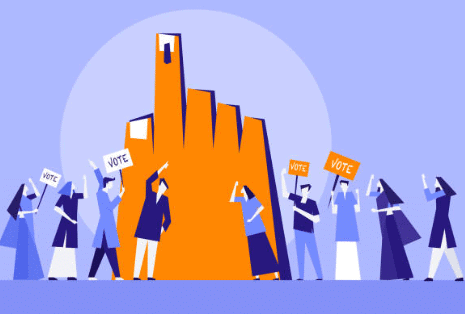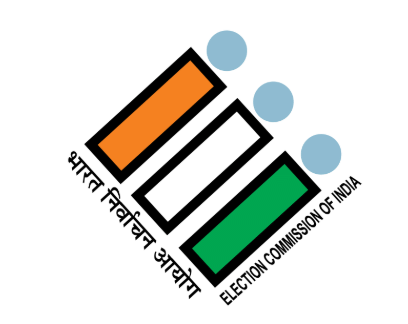Class 11 Political Science Short Questions With Answers - Election And Representation
Q1: What is democracy?
Ans: Democracy is a type of government of the people, for the people and by the people.
- Democracy is a system of government where ultimate power lies with the people.
- It is a governance structure that enables the all-round development of individuals, as the people themselves are the real decision-makers and hold the authority.
Q2: Differentiate between Direct democracy and Indirect democracy.
Ans: 
Q3: What is Election and why it is necessary?
Ans: An election is the process in indirect democracies where citizens vote to select representatives for governance roles. It uses mechanisms like ballots for fair selection.
Necessity:
- Enables public participation in administration.
- Ensures government legitimacy and accountability.
- Facilitates peaceful leadership transitions.
- Represents diverse interests, including minorities.
- Influences policy-making to align with citizen needs.
Elections uphold democratic principles by empowering people to shape their government.

Q4: What is Adult Franchise?
Ans: Adult Franchise grants every adult citizen the right to vote, without discrimination based on caste, religion, gender, or wealth. It upholds equality, assuming adults can make informed choices.
- Voting age varies (e.g., 18 in India, reduced from 21; 17 in Britain).
- Promotes inclusivity, empowering marginalised groups.
- Evolved from suffrage movements, contrasting restricted voting systems.
- In India, Article 326 constitutionalises it for representative democracy.
It strengthens democracy by broadening participation and ensuring diverse representation.
Q5: What do you mean by territorial Representation?
Ans: Territorial Representation divides a state into geographical constituencies, where residents elect representatives to the legislature.
- Constituencies based on population or boundaries; each elects one or more members.
- Voters choose candidates; the winner (by majority/plurality) represents the area.
- Ensures local issues are addressed, enhancing accountability.
- In India, managed by the Delimitation Commission for fair division.
- Advantages: Regional focus and unity; drawbacks: Potential minority neglect or gerrymandering.
It balances national and local interests in democratic systems.
Q6: What is Functional Representation?
Ans: Functional Representation refers to a system where the entire area of a state is divided based on occupational considerations. In this system, each occupational group elects its own representatives. For instance:
- Businessmen elect their own representatives.
- Farmers elect their own representatives.
- Women elect their own representatives.
Q7: Write five features of India’s electoral system.
Ans: The Following are the main features of India’s electoral system:
- Universal Suffrage: Every citizen of India aged 18 and above has the right to vote, ensuring inclusivity in the electoral process.
- Secret Ballot: Voting is conducted by secret ballot, allowing individuals to vote freely without intimidation.
- Independent Election Commission: An autonomous body, the Election Commission of India, oversees the electoral process, ensuring fair and free elections.
- Multi-Party System: India operates a multi-party system, allowing various political parties to compete for power, providing voters with diverse options.
- Reservation of Seats: The electoral system includes provisions for the reservation of seats for Scheduled Castes, Scheduled Tribes, and women, promoting representation.
Q8: What is the First Past the Post System?
Ans: The First Past the Post (FPTP) System, also known as the plurality system, is an electoral method where the candidate receiving the highest number of votes in a constituency wins the seat, regardless of achieving an absolute majority (over 50%).
- Single-Member Constituencies: Each area elects one representative.
- Simple Voting: Voters mark one candidate; no ranking or proportions.
- Advantages: Easy to understand, quick results, promotes stable governments (e.g., two-party systems in the UK, USA).
- Disadvantages: Leads to wasted votes (losers get no representation), disproportional outcomes (party with most votes may not win most seats), and underrepresents minorities.
- Examples: Used in India's Lok Sabha elections, the UK's House of Commons, and Canada's federal elections.
Q9: What is the Proportional Representation (PR) system?
Ans: The Proportional Representation (PR) System is an electoral method where seats in a legislature are allocated to political parties in proportion to the percentage of votes they receive, ensuring fairer representation of voter preferences.
- Multi-Member Constituencies: Larger areas elect multiple representatives.
- Voting Methods: Includes party lists (voters choose parties), Single Transferable Vote (STV) with ranked preferences, or mixed systems.
- Advantages: Reflects diverse opinions, includes minorities and smaller parties, and reduces wasted votes.
- Disadvantages: Can result in fragmented parliaments, coalition governments, and political instability; weaker local links.
- Examples: Used in Germany (mixed PR), the Netherlands (list PR), and South Africa.
Q10: Why was the FPTP system (First Past the Post system), was adopted in India?
Ans: The FPTP system was adopted in India for two main reasons:
- India has single-member constituencies, making the use of the Proportional Representation (PR) system impractical.
- The FPTP system is simpler and easier to understand, while the PR system is more complex. Given India's high illiteracy rate, FPTP provides voters with a clear and straightforward choice. Additionally, it allows for a choice of candidates in each constituency.
Q11: What is the Election Commission?
Ans: The Election Commission is an independent constitutional body responsible for overseeing and conducting free and fair elections in a democracy, particularly in India, under Article 324 of the Constitution.
- Composition: Headed by a Chief Election Commissioner (CEC) and up to two Election Commissioners, appointed by the President.
- Functions: Supervises voter registration, prepares electoral rolls, and conducts elections for Parliament, state legislatures, and President/Vice-President.
- Powers: Enforces Model Code of Conduct, regulates political parties, resolves disputes, and ensures transparency.
- Independence: Autonomous to prevent political interference, with powers akin to civil courts.
- Significance: Upholds democratic integrity by promoting inclusivity and accountability.
Q12: Write five steps of the election process.
Ans: The election process in a democratic system involves multiple steps to ensure free and fair elections. The key steps are as follows:
- Preparation of electoral constituencies and voters' lists.
- Notification and filing of nominations by candidates.
- Scrutiny of nominations, withdrawal of candidates, and finalisation of the list.
- Preparation of ballot papers.
- Arrangement for the election, conducting the polls, counting of votes, and declaration of results.
Q13: Write five defects of the Indian electoral system.
Ans: Five defects of the Indian electoral system are:
- The minority often holds power over the majority.
- The problem of impersonation during voting.
- Booth capturing, where elections are manipulated at polling stations.
- The use of black money to influence elections.
- Inadequate representation of all sections of society, including the entry of people with criminal backgrounds into Parliament and assemblies, leading to political instability.
Q14: Write some electoral reforms.
Ans: To address the electoral defects, several measures have been implemented, and various reforms have been proposed by different committees and commissions. The main reforms are as follows:
- Improved transparency in the electoral process.
- Stricter regulations on campaign financing to ensure fairness.
- Enhancements in the voter registration process.
- Utilisation of technology to streamline voting methods.
Q15: Discuss the role of people in the elections.
Ans: In elections, people are central to democracy, acting as participants and overseers.
- Voting: Selecting representatives to reflect their interests and legitimise government.
- Awareness: Staying informed on candidates and issues for better choices.
- Campaigning: Volunteering, rallying, and mobilising voters via social media.
- Monitoring: Ensuring fair processes by reporting irregularities.
- Inclusivity: Representing diverse groups for equitable policies.
Q16: What is the election? What are the requisites of an election?
Ans: An election is a method for choosing representatives in a democratic system. In a representative democracy, elections are essential because citizens cannot participate in the administration directly. Elected representatives act on behalf of the common people.There are several requirements for an election, including:
- Eligibility criteria for candidates and voters
- A transparent voting process
- Effective electoral management
Q17: Distinguish between the FPTP and PR systems.
Ans: The First-Past-The-Post (FPTP) system is based on the principle that the candidate who secures the highest number of votes among all candidates is declared elected, regardless of whether they achieve 50% of the votes. The winner is simply the candidate who crosses the winning post first.
In contrast, the Proportional Representation (PR) system involves multi-member constituencies and ensures more proportional representation. There are two main types of the PR system:
- Single Transferable Vote (STV)
- List System
In this system, minority social groups are represented in proportion to their population, and political parties receive seats in proportion to the votes they have secured. This approach ensures fairer representation for all groups in society.
Q18: Discuss the composition of the Election Commission of India.
Ans: The Election Commission of India is a three-member body, consisting of:
- One Chief Election Commissioner
- Two Election Commissioners, all of whom have equal powers and receive the same pay.
The Chief Election Commissioner chairs the meetings, performs formal duties, and acts as the spokesperson of the Commission.
- Each Election Commissioner holds a tenure of six years or until the age of 65, whichever comes first.
- To assist the Election Commission, a Chief Electoral Officer is appointed in each state.
- The State Election Commissioner is responsible for conducting local body elections and operates independently from the central Election Commission.
During elections, all employees of the State and Central Governments are placed under the jurisdiction of the Election Commission as per the Representation of the People's Act, 1951, which makes it obligatory for them to perform election duties assigned by the Commission.

Q19: Write the main functions of the Election Commissioner.
Ans: The Election Commissioner has a wide range of functions, which are as under.
- The Election Commissioner supervises the preparation of the updated voters’ list in every state.
- It also determines the timings of the election and prepares the schedules of the election. It notifies the schedule which includes filing of nomination forms, last date of scrutiny, the last date of withdrawals, the date of polling, the date of counting, and declaration of the result.
- Its main duty is to conduct free and fair polls.
- It has the power to implement the model code of elections and punish those who try to violate it.
- It takes decisions regarding repolls in any constituency.
- The Election Commission accords recognition to political parties and allocates flags and symbols to candidates and political parties.
- Election Commission monitors and supervises elections and makes decisions about any disputes related to the election.
Q20: Discuss the position of the Election Commission of India.
Ans:
Q20: Discuss the position of the Election Commission of India. (5 Marks)
The Election Commission of India (ECI) is a constitutional body under Article 324, independent of executive influence to ensure free and fair elections.
Key positions:
- Autonomy: The Chief Election Commissioner (CEC) and Election Commissioners are appointed by the President and can be removed only by impeachment, similar to Supreme Court judges.
- Powers: The Commission superintends all elections (Parliament, states, President); enforces the Model Code of Conduct; registers political parties.
- Composition: It is a multi-member body (CEC plus up to two Commissioners) to maintain impartiality.
- Role in Democracy: Upholds electoral integrity, resolves disputes, promotes voter education and awareness.
- Challenges: Faces criticism for delays or perceived bias, but remains pivotal for maintaining democratic credibility.
Q21: Explain the Single Transferable Vote System.
Ans: The Single Transferable Vote (STV) system is a proportional method of representation used in multi-member constituencies. In this system:
- Every voter can express preferences for as many candidates as there are positions to be filled.
- A candidate is declared elected when they secure a desired quota of votes, based on the first-preference votes.
- If no candidate achieves the required quota in the first round of counting, the votes of the least-voted candidates are transferred to the next preferred candidates, based on voters' subsequent choices, until candidates meet the desired quota.
- The formula to calculate the quota is usually:
Quota = (Total Votes ÷ (Number of Seats + 1)) + 1.
Q22: Explain the List System.
Ans: The List System is a form of Proportional Representation where voters elect parties rather than individuals, and seats are allocated based on each party’s share of votes.
- Party Lists: Parties submit ranked candidate lists; seats are filled proportionally (e.g., 20% votes = 20% seats).
- Types: Closed List (voters choose parties; candidate order fixed by party); Open List (voters influence candidate order).
- Advantages: Fair representation for minorities and smaller parties; reduces wasted votes.
- Disadvantages: Weakens direct voter-to-representative link; may result in unstable coalition governments.
- Examples: Used in Israel, the Netherlands; in India, the Rajya Sabha elections use a variant (STV).
Q23: Why is reservation necessary?
Ans: Reservation is an affirmative action policy in India to uplift historically disadvantaged groups like the Scheduled Castes (SC), the Scheduled Tribes (ST), and Other Backwards Classes (OBC).
Necessity:
- Social Justice: Addresses caste-based discrimination and inequalities arising from centuries of oppression.
- Equal Opportunities: Provides access to education, jobs, and political representation for underrepresented groups.
- Representation: Ensures diverse voices in governance, reducing marginalisation.
- Constitutional Mandate: Enshrined in Articles 15, 16, 330–342 of the Constitution for empowerment.
- Long-term Benefits: Promotes inclusive development, reduces poverty, and fosters national unity.
Q24: What is the role of political parties in the elections?
Ans: Political parties play a crucial role in the election process by shaping political discourse, mobilising voters, and ensuring the smooth functioning of democracy. Their key roles include:
- Offer Political Alternatives: Political parties provide voters with different policy options and programmes, helping them make informed choices.
- Encourage Voter Participation: They actively engage in educating the public and motivating citizens to participate in elections.
- Facilitate Government Formation: Political parties contest elections and form alliances to secure a majority, enabling government formation.
- Enhance Accountability: Through manifestos and promises, political parties hold themselves accountable to the electorate, promoting transparency.
- Promote Unity or Division: While parties can promote unity, some may also focus on divisive issues, affecting social cohesion.
- Indispensable for Elections: Political parties are essential for the effective functioning of elections and democratic governance.
Q25: Why have women not been given reservations in parliament and State Assemblies so far?
Ans: Women's reservation in India's Parliament and state assemblies has been delayed despite the 2023 passage of the Nari Shakti Vandan Adhiniyam (106th Amendment), which reserves 33% seats. The implementation is pending due to several reasons:
- Lack of Consensus: Earlier bills (1996–2010) failed in the Lok Sabha amid opposition from parties fearing loss of male-dominated seats and demands for sub-quotas (OBC/SC/ST women).
- Political Resistance: Concerns that reservations would benefit elite women (urban, upper caste) and reduce opportunities for men.
- Implementation Delays: After the 2023 passage, implementation is tied to the next census (delayed from 2021) and delimitation; the reservation is likely to be effective only from the 2029 elections.
- Patriarchal Norms: Societal biases and low priority for gender issues in politics.
- Other Factors: Frequent changes in government and focus on other priorities stalled progress.
|
43 videos|278 docs|39 tests
|
FAQs on Class 11 Political Science Short Questions With Answers - Election And Representation
| 1. What is the significance of elections in a democratic society? |  |
| 2. How does representation work in a democratic system? |  |
| 3. What are the different types of electoral systems? |  |
| 4. Why is voter turnout important in elections? |  |
| 5. What challenges do elections face in ensuring fair representation? |  |






















